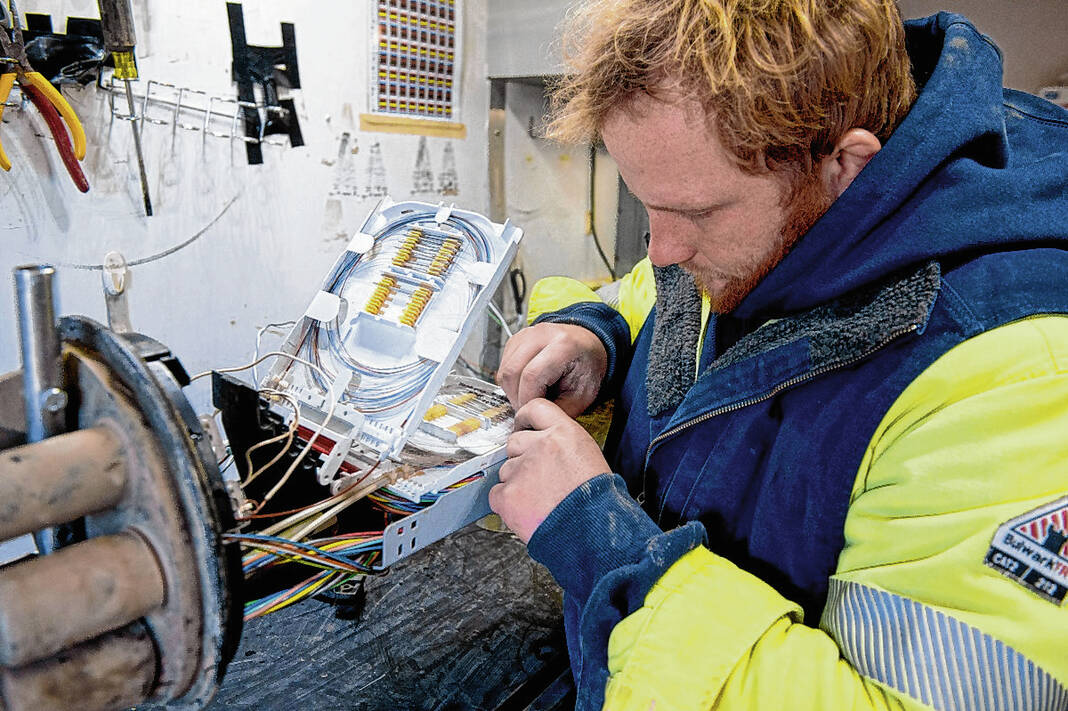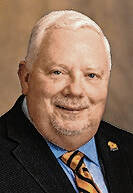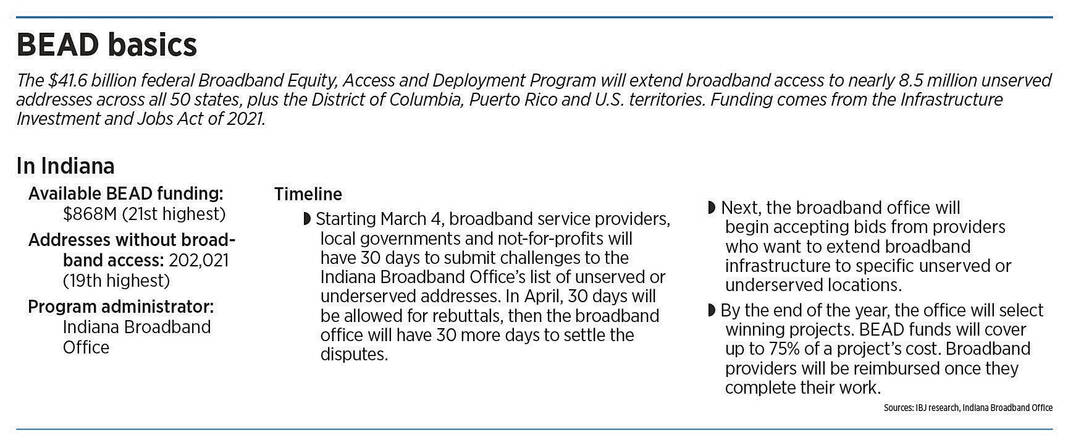
Photo courtesy of NineStar Connect NineStar Connect’s Dusty Mayhugh splices fiber during maintenance of the company’s network.

Plisinski

Burrow

Soards

IBJ Graphic
By Susan Orr | Indianapolis Business Journal
For The Tribune
INDIANAPOLIS — Armed with $868 million in federal funding, the Indiana Broadband Office is embarking on an ambitious project to finally bring broadband to all corners of the state.
That federal funding represents Indiana’s share of the $41.6 billion Broadband Equity, Access and Deployment program—called BEAD—which aims to extend broadband access to nearly 8.5 million U.S. addresses currently unserved or underserved by broadband infrastructure.
Funding for the BEAD program comes from the bipartisan Infrastructure Investment and Jobs Act of 2021.
“This BEAD program truly represents Indiana’s last huge opportunity to get true broadband to every resident in Indiana,” said Michael Burrow, CEO of Greenfield-based utility cooperative NineStar Connect.
The program is targeted at the estimated 202,000 locations in Indiana that are either unserved or underserved by broadband. Unserved means a location has either no internet access or internet access with speeds of less than 25 megabits per second for downloads and 3 megabits per second for uploads. Underserved locations have internet access with download and upload speeds of less than 100 Mbps and 20 Mbps.
According to the National Telecommunications and Information Administration, a household that uses the internet for things like remote learning, streaming videos and web browsing typically needs download speeds of at least 25 Mbps. A small business that uses the internet for things like inventory management, operating point-of-sale terminals and coordinating shipping will need download speeds of at least 50 Mbps.
Within the next several months, broadband providers will have a chance to submit proposals for broadband infrastructure projects that would serve these unserved or underserved areas. Those proposals can request that up to 75% of the project’s cost be subsidized by BEAD funding.
By year’s end, the Indiana Broadband Office will have selected the projects eligible for that funding. Providers will access the funding via a reimbursement system, meaning they must do the work before they get the money.
It’s not the first time money has been offered to increase broadband in Indiana, but it is the first time such a large pool of money has been made available at once.
As a point of comparison, Indiana’s Next Level Connections program, which made its first round of funding awards in 2019, will have distributed a total of $350 million by the time it completes its fourth and final funding round, which is taking place now.
The BEAD program offers more than twice that amount.
“It’s a crazy amount of money for one single program, all in one shot anyways,” said Indiana Broadband Administrator Stephen Cox.
The Indiana Broadband Office has been gearing up for BEAD since last year, and Cox said he has seen high interest in the program from broadband providers of all sizes.
“We anticipate the vast majority of them to probably participate,” he said. “It’s a lot of money.”
It’s premature to know exactly what locations the broadband providers will target because the Indiana Broadband Office hasn’t finalized its official list of BEAD-eligible addresses. That comes next month. Next, broadband providers, government entities and not-for-profits can submit challenges to the official list. Once the challenge process is over and the addresses are finalized, providers can begin submitting bids for specific projects.
BEAD projects might cover an area as small as a census block, but Cox said some providers have bigger ambitions. “Some of them are looking at an entire county.”
NineStar Connect said it already offers broadband access to its entire base of telecommunications customers—about 100,000 people in east-central Indiana. That telecommunications network, which includes more than 5,000 miles of fiber-optic cable, can deliver speeds of up to 10 gigabytes per second for downloads and uploads.
Burrow said NineStar’s BEAD strategy will likely involve looking for opportunities just outside its current service area.
Other co-ops will find their own ways to go after BEAD funding, he said.
“I think there’s going to be unique opportunities out there all across the state of Indiana,” Burrow said. “There’s a lot of opportunities for rural cooperatives out there.”
But the big carriers also have their eyes on the prize.
BEAD “presents an opportunity of historic proportions to finally get every Hoosier connected to the internet,” said AT&T Indiana President Bill Soards. “We’re anxious to see the final rules approved and the eligible address list approved.”
Soards said that, according to the Federal Communications Commission, about 8% of Hoosiers lack basic internet access.
Despite the huge pool of BEAD funding, no one thinks it will be easy to fill in the gaps in the state’s broadband map.
“Rural broadband is a very difficult nut to crack,” said George Plisinski, NineStar’s vice president of engineering.
In rural areas, Plisinski said, a provider’s return on investment might not come for decades because of the cost of running fiber to far-flung addresses in areas that lack a sufficient density of customers. Even with subsidies, he said, the return on investment might still be too far out for commercial providers.
NineStar recently applied for grant funding for a broadband project that would bring that return-on-investment period down from 68.5 years to 13 years, Plinski said. Without such subsidies, he said, that type of project would not be feasible. “No company, cooperative, even a nonprofit, can pencil out an economic case at a 68.5-year return on investment.”
The BEAD project is structured so that the Indiana Broadband Office can consider infrastructure other than fiber networks. If locations don’t get any bids for fiber-based projects, Cox said, his office can accept bids for other technology, like fixed wireless (internet access via towers rather than fiber networks) or even satellite service.
Burrow said the infrastructure situation is parallel to that of electricity utilities in the 1930s, when service had not reached rural parts of the country. In part through the creation of rural electrical co-ops, Burrow said, that infrastructure challenge has been solved.
“In some respects, with this broadband push, it is exactly the same thing that Indiana and a lot of states were facing in the mid-1930s when they were trying to drive electricity to the rural areas,” Burrow said. “And ironically, they’re doing it for very similar reasons. For future economic development and equally so for quality of life and quality of place for those who live in rural areas.”
Burrow said everyone takes electrical service for granted, no matter how rural the community, and broadband has the same potential.
“I think we might be looking back a decade or 15 years from now and (be) surprised how ubiquitous broadband services (are), available all across Indiana.”
